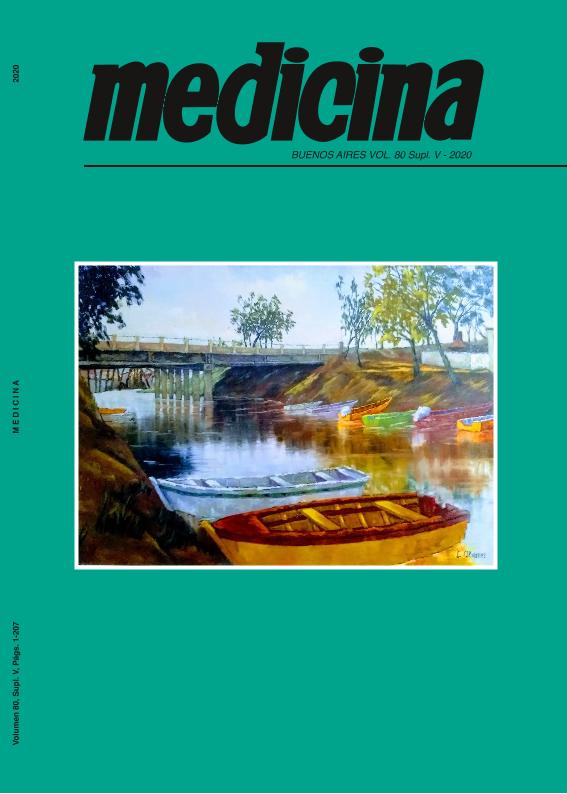Evento
Presence of Shiga toxin producing Escherichia coli in endocervix of asymptomatic pregnant women: Novel pathogen responsible for adverse pregnancy outcomes?
Scalise, Maria Lujan ; Garimano, Nicolás Ezequiel
; Garimano, Nicolás Ezequiel ; Porporato, Melina Mabel
; Porporato, Melina Mabel ; Leonino, P.; Pereyra, A.; Ferreiros, José A.; Casale, Roberto; Amaral, María Marta
; Leonino, P.; Pereyra, A.; Ferreiros, José A.; Casale, Roberto; Amaral, María Marta ; Sacerdoti, Flavia
; Sacerdoti, Flavia ; Ibarra, Cristina Adriana
; Ibarra, Cristina Adriana
 ; Garimano, Nicolás Ezequiel
; Garimano, Nicolás Ezequiel ; Porporato, Melina Mabel
; Porporato, Melina Mabel ; Leonino, P.; Pereyra, A.; Ferreiros, José A.; Casale, Roberto; Amaral, María Marta
; Leonino, P.; Pereyra, A.; Ferreiros, José A.; Casale, Roberto; Amaral, María Marta ; Sacerdoti, Flavia
; Sacerdoti, Flavia ; Ibarra, Cristina Adriana
; Ibarra, Cristina Adriana
Tipo del evento:
Reunión
Nombre del evento:
LXV Reunión anual de la Sociedad Argentina de Investigación Clínica; LXVIII Reunión Anual de la Sociedad Argentina de Inmunología y Reunión Anual de la
Sociedad Argentina de Fisiología
Fecha del evento:
10/11/2020
Institución Organizadora:
Sociedad Argentina de Investigación Clínica;
Sociedad Argentina de Inmunología;
Sociedad Argentina de Fisiología;
Título de la revista:
Medicina (Buenos Aires)
Editorial:
Fundación Revista Medicina
ISSN:
0025-7680
Idioma:
Inglés
Clasificación temática:
Resumen
E. coli can colonize the vagina, usuallyasymptomatically, although epidemiologic studies have showed that the presenceof this bacterium in theendocervix microbiota could be a risk factor for pregnancy. We havepreviously reported that Shiga toxin (Stx) producing E. coli (STEC) infections during pregnancy may cause maternal orfetal damage mediated by Stx2 in rats in early or late stage of gestation. The goal of this study was to detect STEC in the endocervix from asymptomatic pregnant women. Endocervical swabs from 103 asymptomatic pregnant womenwith gestational age of 12 to 30 weeks from the National Hospital Posadas were enrolled.Swab sampleswere enriched in Tryptic Soy Broth andthen streaked on sorbitol-MacConkey (SMAC) agar. E. coli was confirmed by the presence of uidA gene detected by polymerase chainreaction PCR. The positive samples for E.coli were analyzed for STEC virulence factors genes such as: stx1, stx2, eae, rfbO157,lpfAO113 and hcpA genes.The stx2 positive E. coli samples were grown in Luria-BertaniBroth (LB) and the filter-sterilized bacterial supernatants (SN) were usedto evaluated Stx2 activity on Vero, Swan and Hela by cell viability assay. Results: Our results showed that14.6%(15/103) of the endocervical samples were positive for uidA gene. Additionally, we found that8.7% (9/103) was positive for stx2 and 5.8 % (6/103) for lpfAO113 and hcpA genes. The SN of one of themexpressing stx2 gene had a highcytotoxic activity on Vero, Swan 71 and HeLa cells. Stx2 identity was checkedusing an anti-Stx2 antibody in order to neutralize the cytotoxic effects. In conclusion,we demonstrate that STEC can be asymptomatically present in the endocervix andthat can potentially express Stx2. This study may open a new perspective tounderstand whether STEC can be a novel pathogen involved in adverse pregnancyoutcomes.
Palabras clave:
Shiga toxin
,
Escherichia coli
,
endocervix
,
microbiota
Archivos asociados
Licencia
Identificadores
Colecciones
Eventos(IFIBIO HOUSSAY)
Eventos de INSTITUTO DE FISIOLOGIA Y BIOFISICA BERNARDO HOUSSAY
Eventos de INSTITUTO DE FISIOLOGIA Y BIOFISICA BERNARDO HOUSSAY
Citación
Presence of Shiga toxin producing Escherichia coli in endocervix of asymptomatic pregnant women: Novel pathogen responsible for adverse pregnancy outcomes?; LXV Reunión anual de la Sociedad Argentina de Investigación Clínica; LXVIII Reunión Anual de la Sociedad Argentina de Inmunología y Reunión Anual de la
Sociedad Argentina de Fisiología; Argentina; 2020; 140-141
Compartir



